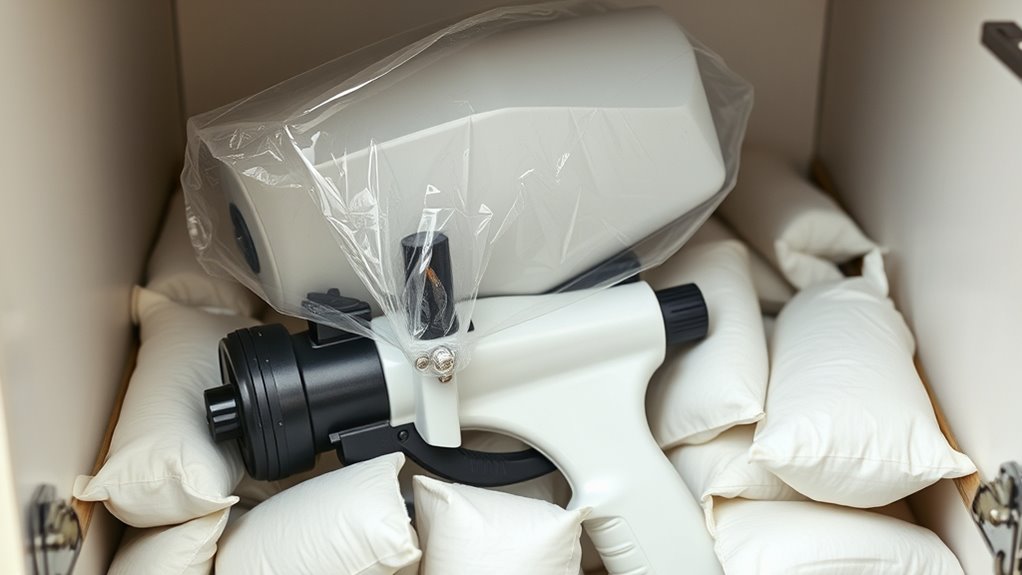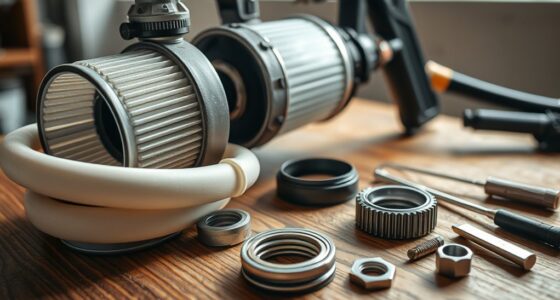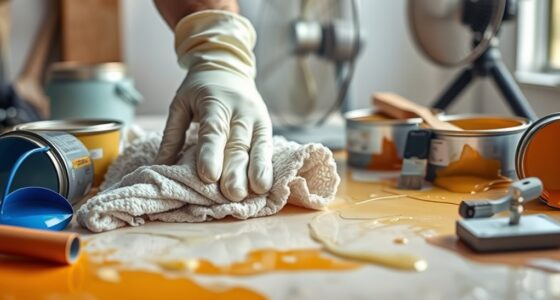To prevent mold and mildew in your paint sprayer, make certain you clean and thoroughly dry all parts before storage. Store it in a well-ventilated, climate-controlled area, or use dehumidifiers and moisture absorbers like silica gel packs. Seal the equipment in airtight containers or bags to keep out humidity, dirt, and dust. Regularly inspect your sprayer for signs of mold, and take action immediately if you notice any. Keep these tips in mind to keep your sprayer mold-free longer.
Key Takeaways
- Ensure the sprayer is thoroughly cleaned and dried before storing to remove residual paint and moisture.
- Store the sprayer in a well-ventilated area with low humidity, using dehumidifiers or silica gel packs if possible.
- Keep the equipment in airtight containers or covered with protective bags to prevent dust, dirt, and moisture buildup.
- Regularly inspect the sprayer for signs of mold or mildew and clean again if any are detected.
- Avoid storing in enclosed spaces like garages or basements; opt for climate-controlled environments to reduce mold risk.

Mold and mildew can quickly develop in your paint sprayer if you don’t take proper precautions, especially during periods of storage or when switching between different paints. To prevent this, you need to focus on good air circulation and moisture control. Ensuring proper air flow around your stored equipment helps keep moisture levels low, making it less inviting for mold spores to settle and grow. When you store your sprayer in a garage, basement, or shed, avoid tight, enclosed spaces that trap humidity. Instead, place it in an area with good ventilation or use a dehumidifier to reduce excess moisture in the air.
Moisture control is critical because mold thrives in damp environments. Before storing your sprayer, always clean it thoroughly to remove residual paint, which can trap moisture and create a breeding ground for mold. Use a cleaning solvent suitable for your sprayer’s material, and make sure to flush out all parts, including hoses and nozzles. After cleaning, dry every component completely with a clean cloth or compressed air. Moisture left inside the sprayer can lead to mold growth, even if the outside looks dry.
Another effective way to control moisture during storage is to keep your equipment in a climate-controlled environment. If you live in a humid climate, consider storing your sprayer in a room with air conditioning or a dehumidifier. These devices help regulate humidity levels, preventing mold spores from settling and proliferating. Additionally, placing silica gel packets or moisture absorbers inside your storage container can help maintain a dry environment, especially if the space tends to fluctuate in humidity. Incorporating proper storage techniques can further reduce the risk of mold development.
It’s also a good idea to store your sprayer in a sealed, airtight container or covered with a protective bag to shield it from dust, dirt, and moisture. When you’re ready to use it again, inspect the sprayer carefully for any signs of mold or mildew before proceeding. If you notice any musty smell or visible mold, clean and dry the equipment again before use.
Frequently Asked Questions
How Long Can I Store My Paint Sprayer Before Cleaning?
You can typically store your paint sprayer for up to two weeks without cleaning, but it’s best to clean it sooner if possible. During this storage duration, paint residuals can harden and clog the system. To avoid issues, clean your sprayer thoroughly after each use, especially if you plan to store it longer. Proper cleaning guarantees your equipment stays in good shape and works smoothly when you need it again.
Are There Specific Storage Environments Best for Preventing Mold?
Think of your storage environment like a cozy, dry cabin for your paint sprayer. To prevent mold, you should choose a space with humidity control and temperature regulation, much like a climate-controlled closet. Keep it cool and dry, avoiding damp basements or hot attics. Properly maintaining these conditions helps stop mold growth, ensuring your sprayer stays in top shape and ready for your next project.
Can I Use Household Cleaning Products to Disinfect the Sprayer?
You can use household disinfectants or eco-friendly cleaners to disinfect your paint sprayer, but choose products safe for the equipment. Avoid harsh chemicals that may damage parts. Mix a diluted solution according to the label, then run it through the sprayer to clean all components thoroughly. Rinse well with water afterward. Using gentle, effective household disinfectants helps prevent mold and mildew buildup without harming your sprayer.
What Are the Signs That Mold Has Developed Inside My Sprayer?
If you’re wondering about signs that mold has developed inside your sprayer, look for a strong mold smell, which indicates mold growth. Also, check for any visible growth, such as fuzzy or dark spots inside the container or nozzles. These signs show mold is present, and you should clean and disinfect your sprayer thoroughly before using it again to prevent damage and guarantee safe application.
Is It Necessary to Use Mold Inhibitors in Stored Paint Sprayers?
Imagine your paint sprayer as a ship in harbor, waiting for the next voyage. Should you add mold inhibitors to your storage solutions? It’s wise, especially if you won’t use the sprayer soon. Mold inhibitors help prevent mold and mildew growth, protecting your equipment. Using them guarantees your sprayer stays clean and ready without costly cleanup later. So, yes, adding mold inhibitors is a smart move during storage.
Conclusion
By taking these simple steps, you guarantee your paint sprayer stays fresh and ready for your next project. Proper cleaning, thorough drying, and storing in a dry place are your best defenses against mold and mildew. Remember, neglecting these steps is like inviting trouble to settle in—don’t let mold sneak in when you least expect it. Keep your equipment clean, and it’ll serve you well, project after project, like a trusted friend standing the test of time.
Franz came aboard the Paint Sprayer Zone team with a background in both journalism and home renovation. His articulate writing style, combined with a passion for DIY projects, makes him an invaluable asset. Franz has a knack for breaking down technical jargon into easy-to-understand content, ensuring that even the most novice of readers can grasp the complexities of paint sprayers.










